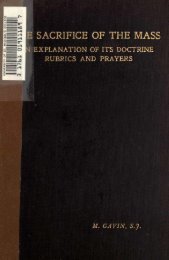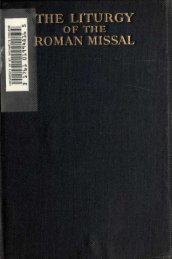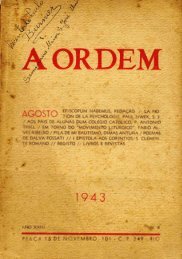E SACRIFICE OF THE MASS
E SACRIFICE OF THE MASS
E SACRIFICE OF THE MASS
Create successful ePaper yourself
Turn your PDF publications into a flip-book with our unique Google optimized e-Paper software.
I 44<br />
<strong>THE</strong> END <strong>OF</strong> <strong>MASS</strong>.<br />
This prayer naturally leads to the blessing that<br />
follows, for every blessing comes from the Sacrifice of<br />
the Mass, and the priest is in every case the channel.<br />
After the prayer Placeat the priest kisses the altar<br />
and pronounces the blessing : Benedicat vos omnipotens<br />
Deus, Pater, et Filius, % et Spiritus Sanctus.<br />
This custom of the priest s blessing at Mass is not<br />
very ancient. There is no proof up to the eleventh<br />
at the end of Mass. From the tenth<br />
century of a blessing<br />
century many Bishops in various places began to give<br />
the blessing at the end of Mass instead of before the<br />
Communion. By degrees priests also began to bless<br />
at the end of Mass. At one time priests gave the<br />
blessing with the triple sign of the Cross, as Bishops<br />
do now. Pius V. restricted priests to a blessing with<br />
one sign of the Cross, except at High Mass, when he<br />
allowed them the triple sign. At the revision of the<br />
Roman Missal the rule was at length firmly estab<br />
lished that Bishops at the end of Mass bless with<br />
a triple sign of the Cross and priests with a single.<br />
Clement VIII. made the rule absolute which forbids<br />
a priest to bless with the triple sign of the Cross. 1<br />
The Requiem Mass without a blessing at the end<br />
reminds us of the centuries when no blessing was given<br />
by priest or Bishop.<br />
The custom of reading the beginning of St. John s<br />
Gospel<br />
at the end of Mass dates from the thirteenth<br />
century, and that only in certain places. Pius V., in<br />
revising the Missal, imposed on all priests the obliga<br />
tion of saying St. John s Gospel at the end of Mass<br />
except on certain days when the rubrics prescribe<br />
another Gospel.<br />
1 An allusion to the withdrawal of the permission for the triple<br />
of the Cross is seen in the Rubric of the Roman Missal, "et<br />
sign<br />
versus ad populum,senifl tantum benedicem etiam in Missis Solemnibus."






